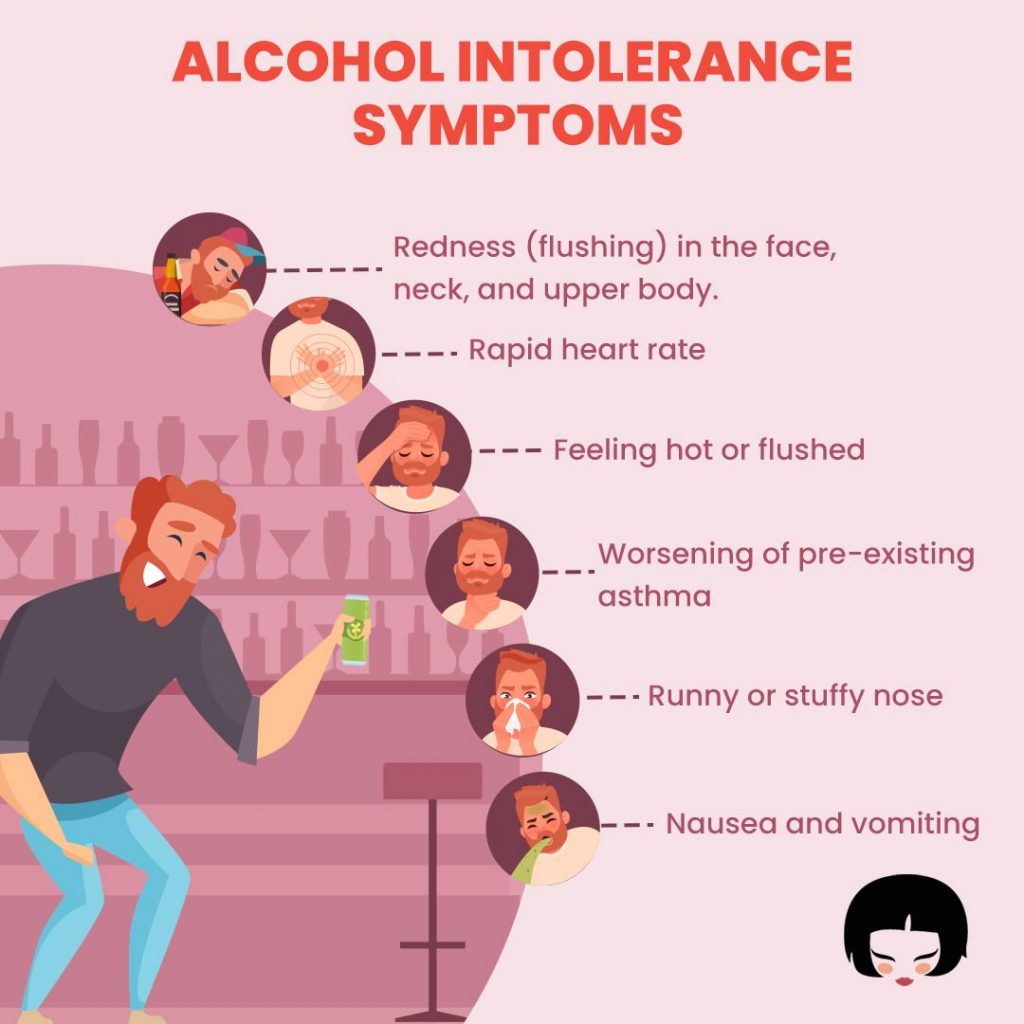Do you ever have a pint with friends or a glass of wine with coworkers and feel awful almost right away? This reaction may not be that you’re a “lightweight” but that you have something called Alcohol Intolerance.
Here’s everything you need to know about this negative reaction to alcohol, whether you might have it and best steps to avoid it.
What is alcohol intolerance?
The term “alcohol intolerance” is a little bit misleading and is often used in the wrong context. This condition can be caused by two different situations: either you have a genetic condition or you have a sensitivity or allergy to an ingredient used in an alcoholic drink.
Some believe that alcohol intolerance is interchangeable with an alcohol allergy. This isn’t true. A real alcohol allergy does exist, but is extremely rare. It’s more likely that you have the genetic condition that leads to alcohol intolerance, or an allergy or sensitivity to an ingredient in your drink. Let’s look at these two separate reasons more closely.
Alcohol intolerance caused by a genetic condition
For many people, alcohol can trigger a really uncomfortable reaction that almost feels like an allergic reaction. This genetic condition is often referred to as Asian Flush or Asian Glow because such a high percentage of Asian people have it. While Asian Glow symptoms can look like a traditional allergy, it’s not the same thing.
Although it’s called Asian Flush or Asian Glow, it’s important to remember that this reaction is not just impacting those of Asian-descent. Caucasians can have alcohol intolerance, too.
To include other nationalities, we can also call this condition Alcohol Flushing or Alcohol Flush Reaction. To make things more confusing, it’s referred to by even more names and titles but they all basically mean the same thing. In short, all these different names refer to a genetic condition that causes negative reactions when you drink alcohol.
Some names for alcohol intolerance:
- Asian Glow
- Asian Flush
- Alcohol Flushing
- Alcohol Flush Reaction
What happens in the body during alcohol intolerance caused by Asian Flush
In those with this genetic condition, the body is unable to break down alcohol properly. Alcohol enters the system and breaks down into acetaldehyde, which is a toxic chemical. Normally, acetaldehyde would break down further until it is eventually eliminated from the body completely.
Unfortunately fo those with Asian Flush, the body is unable to adequately break down acetaldehyde, causing it to wreck havoc on the body.
Acetaldehyde is the chemical responsible for the negative symptoms you feel after drinking alcohol when you have this condition.

Alcohol intolerance symptoms
- nausea
- dizziness
- headaches
- rapid heart rate
- feeling hot or flushed
- stuffy nose or congestion
- more severe hangovers the following day
- red skin (especially flushing on your face, neck and even shoulders and upper arms)
When acetaldehyde builds up when consuming alcohol, the body and the immune system tries its best to fight it. Unfortunately acetaldehyde causes some really uncomfortable and embarrassing symptoms until the body can get rid of it. The most common symptoms reported are stuffy nose and skin flushing, especially on the face. This is why it’s often called Asian “Flush” or Asian “Glow” as skin flushing on the face is very obvious.
In short, those with Asian Flush become overwhelmed with toxic acetaldehyde. It’s this chemical that causes negative symptoms when drinking alcohol. Having increased levels of acetaldehyde for a longer period of time also causes worse hangovers, or hangovers that last much longer than usual.
Alcohol intolerance caused by an ingredient
If you don’t have Asian Flush, you can still experience negative symptoms when drinking alcohol. While a true allergy to alcohol itself is rare, it’s much more common to be intolerant or sensitive to ingredients in your drink. You may even be allergic to a part of your drink, instead of the alcohol itself.
Ingredients in alcohol beverages that cause negative reactions include:
- grapes
- histamine
- chemicals
- other allergens in alcohol
- sulfites or other preservatives
- grains, corn, hops, wheat or rye
If you have a sensitivity to grains, drinking a beer would be an easy way to experience a negative reaction. While it may feel like you’re allergic to beer, you’re actually have a reaction to the grain used to make the beer instead. It’s like having a negative reaction to an ice cream milkshake. You’re not necessarily allergic to ice cream milkshakes, but may be lactose intolerant instead.
Sulfites are another common culprit for negative symptoms when drinking alcohol. If you find that sulfites in wine cause a reaction, try looking for sulfite-low or sulfite-free wines and see if you experience any negative symptoms. This should be printed on the wine’s label if you’re not sure.
A true alcohol allergy
A true allergy to alcohol is very rare, but does still exist. For those with this allergy, as little as 1ml of alcohol is enough to “provoke severe rashes, difficulty breathing, stomach cramps or collapse” as reports the Australasian Society of Clinicial Immunology and Allergy (ASCIA).
1ml of pure alcohol would be equivalent to 10ml of wine or a mouthful of beer. Such a small amount of alcohol causes a huge reaction and can be extremely serious. Those with a true alcohol allergy could even experience anaphylaxis symptoms.
Those who experience severe symptoms from very small amounts of alcohol should get medical advice before drinking again. It’s important to know for sure if you have an allergy before potentially risking your life over a glass of wine.
The ASCIA also recommends that a true allergy to alcohol be treated like any other severe allergy:
- identify and avoid the cause
- wear a medical identification bracelet
- carry adrenaline (epinephrine) as part of an emergency action plan if individuals are at risk of potentially life threatening allergic reactions

How can I tell if I have alcohol intolerance?
There are a few ways you can tell if you have an alcohol intolerance, and whether it’s caused by Asian Flush or an intolerance to a specific ingredient.
1. Do you experience negative symptoms when drinking any type of alcohol? Make an elimination diet
If you find that only certain drinks cause you negative symptoms, it’s more likely to be caused by a sensitivity to an ingredient rather than a genetic condition. Those with Asian Flush react to all types of alcohol, because they all create acetaldehyde. If your symptoms are only caused by an ingredient, you may find that you can drink certain types of alcoholic drinks with little-to-no reaction.
Utilising an elimination diet is a great way to find which food or drinks give you a negative reaction. This is often used when trying to figure out food intolerances like gluten or lactose. Remove alcoholic drinks from your diet, then slowly test individual drinks over time. You may find that options like mixed drinks are fine, but red wine gives you a strong negative reaction.
2. Test for alcohol intolerance with genetic tests
Companies like 23andMe use your genetic profile to test for alcohol flush reaction in their health kits. However it is expensive and you do receive a full health analysis. If you’re looking only for the alcohol flush reaction details, it’s a bit overkill, but it’s a scientific way to know if you have Asian Flush.
3. Take an allergy test at your doctors
If you want to better understand your allergies, schedule a classic skin prick test. You’ll need to call your doctor’s office to arrange an allergy test, either done by your doctor or an allergy specialist. They will prick your skin with various substances and see which one you react negatively to. You may find that common alcoholic drink ingredients are on your list of allergens.
Alcohol intolerance prevention
Unfortunately there are no cures or medicines that can fully prevent or stop an alcohol intolerance reaction caused by Asian Flush. If you have this genetic condition, you’ll have it for life.
The most obvious course of action is to avoid alcohol and you won’t experience negative symptoms. However, that’s not always the easiest choice, especially in social settings.
There are a few supplements on the market currently that help break down toxic acetaldehyde quickly so your alcohol flushing reaction is minimised. While these are not cures, they do help those enjoy alcohol with less of a negative reactions. If you’re looking for an Asian Flush supplement, make sure to find something that specifically targets acetaldehyde.
Previously, many people with alcohol intolerance would recommend medicines like Pepcid AC or Zantac to their friends. These drugs may seem like they help reduce facial flushing caused by alcohol, but unfortunately they only mask the symptom. Drugs like Pepcid AC help minimise getting a bright red face, but it doesn’t actually do anything for the internal symptoms or the build up of toxic acetaldehyde.


Leave a Reply